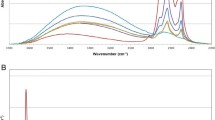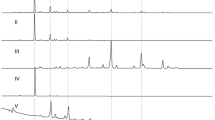Abstract
The concentrations of three individual stilbenes, pinosylvin (PS), pinosylvin monomethyl ether (PSM), and pinosylvin dimethyl ether (PSD), and the total concentration of phenolic compounds were determined in 34-year-old Scots pines which were known to have either decay-resistant or susceptible heartwood. The sample trees were selected from two progeny tests among 783 trees; the decay resistance of which had been screened earlier in vitro against a brown-rot fungus Coniophora puteana. Ten decay-resistant and ten susceptible trees from each of the progeny tests were analysed. In the heartwood of the resistant trees, the average total concentration of the stilbenes was 7.5 and 6.4 mg/g of dry weight, while in the heartwood of the susceptible trees the respective values were 5.0 and 4.7 mg/g. The difference between the decay resistant and susceptible trees was statistically significant in both progeny tests. The difference in concentration of total phenolics, analysed by the Folin-Ciocalteu method, was also significant. A high concentration of phenolics was connected to the low hygroscopicity of wood. The results support the argued hypothesis that the stilbenes make a contribution to the differences in the decay rate of natural wood substrate. On the other hand, the results show that the stilbenes alone do not explain the variation in decay rate.

Similar content being viewed by others
References
Celimene CC, Micales JA, Ferge L, Young RA (1999) Efficacy of pinosylvins against white-rot and brown-rot fungi. Holzforschung 53:491–497
Erdtman VH (1939) Die phenolischen Inhaltsstoffe des Kiefernkernholzes, ihre physiologische Bedeutung und hemmende Einwirkung auf die normale Aufschließbarkeit des Kiefernkernholzes nach dem Sulfitverfahren. Liebigs Ann Chem 539:116–127
Erdtman VH, Rennerfelt E (1944) Der Gehalt des Kiefernkernholzes an Pinosylvin-Phenolen. Ihre quantitative Bestimmung und ihre hemmende Wirkung gegen Angriff verschiedener Fäulpilze. Sven Papperstidn 47:45–56
Harju AM, Kainulainen P, Venäläinen M, Tiitta M, Viitanen H (2002) Differences in resin acid concentration between brown-rot resistant and susceptible Scots pine heartwood. Holzforschung 56:479–486
Harju AM, Venäläinen M (2002) Genetic parameters regarding the resistance of Pinus sylvestris heartwood to decay caused by Coniophora puteana. Scand J Forest Res 17:199–205
Harju AM, Venäläinen M, Beuker E, Velling P, Viitanen H (2001) Genetic variation in the decay resistance of Scots pine wood against brown rot fungus. Can J Forest Res 31:1244–1249
Hart JH (1981) Role of phytostilbenes in decay and disease resistance. Annu Rev Phytopathol 19:437–458
Hart JH, Shrimpton DM (1979) Role of stilbenes in resistance of wood to decay. Phytopathology 69:1138–1143
Higuchi T (1985) Biosynthesis and biodegradation of wood components. Academic, Orlando, p 679
Julkunen-Tiitto R (1985) Phenolic constituents in the leaves of northern willows: methods for the analysis of certain phenolics. J Agr Food Chem 33:213–217
Kainulainen P, Satka H, Mustaniemi A, Holopainen JK, Oksanen J (1993) Conifer aphids in an air-polluted environment. II. Host plant quality. Environ Pollut 80:193–200
Loman A (1970) Bioassays of fungi isolated from Pinus contorta var. latifolia with pinosylvin, pinosylvinmonomethyl ether, pinobanksin, and pinocembrin. Can J Botany 48:1303–1308
Rennerfelt E (1943) Die Toxizität der phenolischen Inhaltsstoffe des Kiefernkernholzes gegenüber einigen Fäulnispilzen. Sven Bot Tidskr 37:83–93
Rennerfelt E (1945) The influence of the phenolic compounds in the heartwood of Scots pine (Pinus silvestris L.) on the growth of some decay fungi in nutrient solution. Sven Bot Tidskr 39:311–318
Rennerfelt E (1947) Några undersökningar över olika rötsvampars förmåga att angripa splint- och kärnved hos tall. Medd Skogsför 36:1-24
Rennerfelt E, Nacht G (1955) The fungicidal activity of some constituents from heartwood of conifers. Sven Bot Tidskr 49:419–432
Ritschkoff A-C (1996) Decay mechanisms of brown-rot fungi. Technical Research Centre of Finland, Espoo. VTT Publications 268, p 67
SAS Institute Inc (1996) SAS/STAT Software: changes and enhancements through release 6.11. SAS Institute Inc, Cary, NC, p 1104
Scheffer TC, Cowling EB (1966) Natural resistance of wood to microbial deterioration. Annu Rev Phytopathol 4:147–170
Schultz TP, Nicholas DD (2000) Naturally durable heartwood: evidence for a proposed dual defensive function of the extractives. Phytochemistry 54:47–52
Schultz TP, Nicholas DD, Fisher TH (1997) Quantitative structure-activity relationships of stilbenes and related derivatives against wood-destroying fungi. In: Pandalai SG (ed) Recent research development in agricultural and food chemistry, vol 1. pp 289–299
Singleton VL, Orthofer R, Lamuela-Raventós RM (1974) Analysis of total phenols and other oxidation substrates and antioxidants by means of Folin-Ciocalteu reagent. Am J Enol Viticult 25:152–178
Steffen A, Frühwald A, Tamminen Z, Puls J (1990) Biological, chemical, and physical properties of Scots pine from Sweden under special consideration of crown defoliation. The Swedish University of Agricultural Sciences, Department of Forest Products, Report No 217, Uppsala, p 312
Venäläinen M, Harju AM, Nikkanen T, Paajanen L, Velling P, Viitanen H (2001) Genetic variation in the decay resistance of Siberian larch (Larix sibirica Ledeb.) wood. Holzforschung 55(1):1–6
Viitanen H, Paajanen L, Nikkanen T, Velling P (1998) Decay resistance of Siberian larch wood against brown rot fungi. Part 2. The effect of genetic variation. The International Research Group on Wood Preservation, Stockholm, IRG Doc. No: IRG/WP 98–10287, p 6
Viitanen H, Ritschkoff A-C (1989) Ruskolahon kehittyminen ja leviäminen puurakenteissa [Brown-rot decay in wooden construction]. Valtion teknillinen tutkimuskeskus, Technical Research Centre of Finland, Research Reports 637, p 85
Vologdin AI, Razumova AF, Charuk EV (1979) Die Bedeutung der Extraktstoffe fur die Permeabilität von Kiefern- und Fichtenholz. Holztechnol 20(2):67–69
Yamada T (1992) Biochemistry of gymnosperm xylem responses to fungal invasion. In: Blanchette RA, Biggs AR (eds) Defense mechanisms of woody plants against fungi. Springer, Berlin Heidelberg New York, pp 146–164
Acknowledgements
This study has been supported by the Academy of Finland (Resource Council for the Environment and Natural Resources, projects no. 43140, 43159 and 620012) and belongs to The Finnish Forest Cluster Research Programme WOOD WISDOM. We thank Arto Haatainen, Heikki Kinnunen, Eija Matikainen, and Jussi Tiainen from Punkaharju Research Station for looking after the wood sampling, Terhi Vuorinen for the chemical analyses in Kuopio, Tapio Laakso and Veikko Kitunen for the GLC-MS analyses in Vantaa, and John Derome for revising the language.
Author information
Authors and Affiliations
Corresponding author
Rights and permissions
About this article
Cite this article
Venäläinen, M., Harju, A.M., Saranpää, P. et al. The concentration of phenolics in brown-rot decay resistant and susceptible Scots pine heartwood. Wood Sci Technol 38, 109–118 (2004). https://doi.org/10.1007/s00226-004-0226-8
Received:
Published:
Issue Date:
DOI: https://doi.org/10.1007/s00226-004-0226-8




